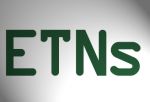 Exchange Traded Funds (“ETFs”) and Exchange Traded Notes (“ETNs”) are similar in some ways but have major differences as well. When you buy an ETF, you receive an ownership stake in a pooled investment, structured as an independent entity. When you buy an ETN, you are essentially lending your money to the issuer. All you own is an IOU, and the identity of “I” and “U” may not be entirely clear.
Exchange Traded Funds (“ETFs”) and Exchange Traded Notes (“ETNs”) are similar in some ways but have major differences as well. When you buy an ETF, you receive an ownership stake in a pooled investment, structured as an independent entity. When you buy an ETN, you are essentially lending your money to the issuer. All you own is an IOU, and the identity of “I” and “U” may not be entirely clear.
The key feature making ETFs and ETNs similar is their ability to create and redeem shares via in-kind or cash exchanges. This ongoing process is the essence of the ETF/ETN structure. In addition to providing liquidity and tax efficiency, it keeps trading prices aligned with net-asset-values, avoiding (or at least minimizing) the discounts and premiums associated with closed-end funds.
The key feature making ETFs and ETNs different is that ETFs are fully collateralized stand-alone entities, independent of the sponsor, issuer, and manager. ETNs are senior unsecured debt obligations of the issuing firm. ETNs own nothing, are not collateralized, and carry the credit risk of the issuing firm.
An important but often overlooked point is that the issuer may be different from the ETN’s sponsor and not identified in the product’s name. Occasionally, identifying the issuer is straightforward: Morgan Stanley (MS) issues the Morgan Stanley brand of ETNs, and Credit Suisse (CS) issues the Credit Suisse ETNs.
Some firms use brand names. iPath ETNs are from Barclays (BCS) and ETRACS are issued by UBS (UBS). Some firms issue ETNs under multiple brands. For example, JPMorgan (JPM) issues ETNs that carry the JPMorgan name as well as products with the KEYnotes brand.
If you own an ELEMENTS brand ETN, identifying the issuer becomes more difficult. This is because ELEMENTS is the only ETN sponsor currently using multiple issuers – three different firms in this case.
By my count there are currently 196 ETNs available to US investors, marketed under 15 different brands, and issued by 11 different firms. The table below can help identify the company to which you are lending money when you buy a given ETN brand.
ETN Sponsors and Issuers
| ETN Brand | Issuer/Borrower | Qty | Assets ($millions) |
|---|---|---|---|
| Barclays | Barclays | 8 | 142 |
| Claymore | Goldman Sachs | 1 | 3 |
| Credit Suisse | Credit Suisse | 5 | 375 |
| C-Tracks | Citigroup | 1 | 12 |
| ELEMENTS | Credit Suisse | 1 | 3 |
| ELEMENTS | Deutsche Bank | 2 | 15 |
| ELEMENTS | HSBC | 1 | 35 |
| ELEMENTS | Swedish Export Credit Corp | 7 | 1,361 |
| ETRACS | UBS | 39 | 865 |
| GS Connect | Goldman Sachs | 1 | 70 |
| iPath | Barclays | 73 | 6,703 |
| JPMorgan | JPMorgan Chase & Co. | 3 | 3,242 |
| KEYnotes | JPMorgan Chase & Co. | 1 | 17 |
| Market Vectors | Morgan Stanley | 4 | 165 |
| Morgan Stanley | Morgan Stanley | 2 | 28 |
| PowerShares DB | Deutsche Bank | 28 | 1,221 |
| RBS | RBS | 5 | 119 |
| VelocityShares | Credit Suisse | 14 | 632 |
All data as of 10/31/2011.
Disclosure covering writer, editor, and publisher: No positions in any of the securities mentioned. No positions in any of the companies or ETF sponsors mentioned. No income, revenue, or other compensation (either directly or indirectly) received from, or on behalf of, any of the companies or ETF sponsors mentioned.